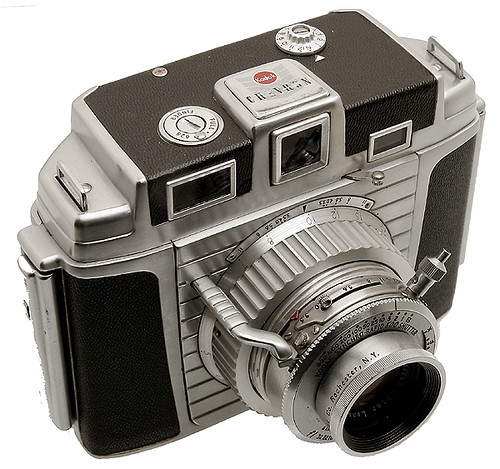Difference between revisions of "Kodak Chevron"
(Added photograph) |
(Added some text) |
||
| Line 11: | Line 11: | ||
| − | The '''Kodak Chevron''' is a 6×6cm leaf-shutter camera for [[620 film]]. Much like its more popular cousin, the [[Medalist]], it is a higher-end member of the [[Kodak]] 620 camera family. It is equipped with a 78mm Ektar with maximum aperture of f/3.5 and top shutter speed of 1/800 of a second. An 828-format (non-perforated 35mm) adapter came with the camera originally and the finder adjusts appropriately. | + | The '''Kodak Chevron''' is a 6×6cm coupled-rangefinder leaf-shutter camera for [[620 film]]. Much like its more popular cousin, the [[Medalist]], it is a higher-end member of the [[Kodak]] 620 camera family. It is equipped with a four-element 78mm Ektar with maximum aperture of f/3.5 and top shutter speed of 1/800 of a second. An 828-format (non-perforated 35mm) adapter came with the camera originally and the finder adjusts appropriately. The viewfinder adjusts for parallax, there is a separate finder for the rangefinder. The automatic exposure counter is driven by a toothed roller next to the supply spool. It has a hinged back that can be opened from either side and also removed completely. |
| − | The Camera was made in Rochester between 1953-56 and is of an extremely durable and heavy | + | The Camera was made in Rochester between 1953-56 and is of an extremely durable and heavy aluminium construction. It sold for $215 in 1953. |
Revision as of 02:16, 21 August 2016

|
| Kodak Chevron image by Rick Soloway (Image rights) |
The Kodak Chevron is a 6×6cm coupled-rangefinder leaf-shutter camera for 620 film. Much like its more popular cousin, the Medalist, it is a higher-end member of the Kodak 620 camera family. It is equipped with a four-element 78mm Ektar with maximum aperture of f/3.5 and top shutter speed of 1/800 of a second. An 828-format (non-perforated 35mm) adapter came with the camera originally and the finder adjusts appropriately. The viewfinder adjusts for parallax, there is a separate finder for the rangefinder. The automatic exposure counter is driven by a toothed roller next to the supply spool. It has a hinged back that can be opened from either side and also removed completely.
The Camera was made in Rochester between 1953-56 and is of an extremely durable and heavy aluminium construction. It sold for $215 in 1953.

|
| image by Geoff Harrisson (Image rights) |